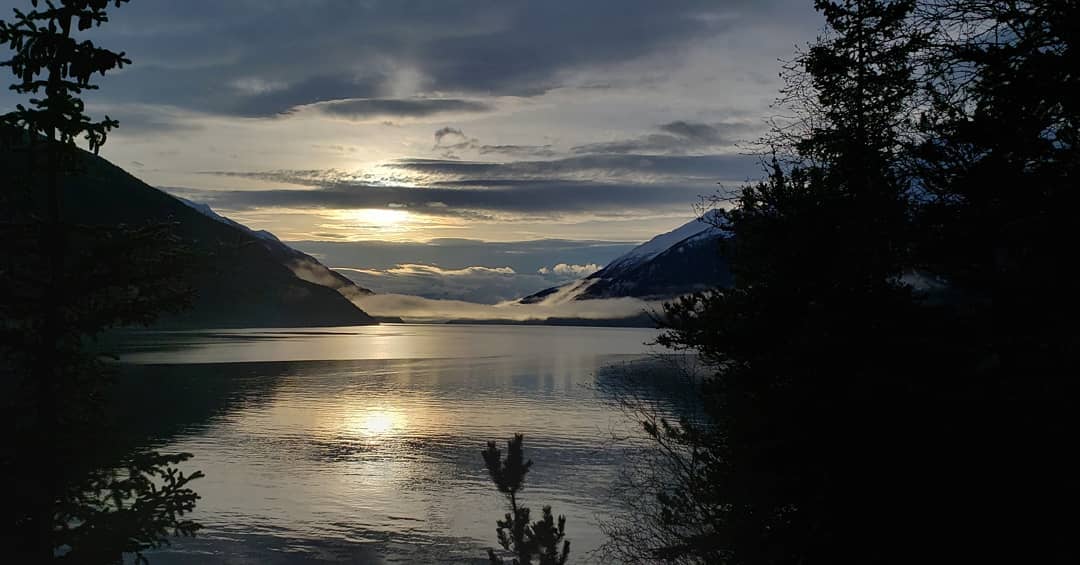Ask a Tour Salesperson:
Is It Dark All the Time During the Winter?

This is high noon during late December in Skagway. Notice that it is not dark but the sun is low on the horizon at its highest point. Very interesting.
When people go on vacation, they want to learn all about the place they’re visiting. This is normal because humans are inquisitive by nature. When traveling to Skagway, there are many experts who are highly qualified to answer questions.
A Park Ranger may be able to answer questions about the Gold Rush. A naturalist can explain details about the many different species of flora and fauna. However, when you want the stone-cold truth about any topic, there is only one person you can fully trust – the tour salesperson.
In today’s blog, we are going to answer one of the more common questions we hear in the tour booth, “Is it dark all the time during the winter?”
During the tourist season, there is a lot of sunlight
Why do people ask about daylight during the winter? Probably for a few different reasons…
- They noticed that there is a lot of daylight during the summer season when they visit.
- They saw a tv show or movie that said it was dark all the time in the winter.
- They heard someone say it was dark all the time in the winter.
- They are very interested in the Earth’s axial tilt.
In Skagway, there is a lot of daylight during the tourist season. In fact, there is 18 hours of daylight during summer solstice but it really never gets completely dark because the sun doesn’t dip too far below the horizon. During the winter solstice, there are only 6 hours of daylight in Skagway. So it’s like daylight and darkness switch places. However, there is more to this story.
The Earth’s axial tilt and how it influences daylight
During summer, the sun hangs high in the sky at midday. If you’re from the Lower 48, this seems very normal but the sun is not traveling from east to west. It’s actually traveling more from the northeast to the northwest on a semicircular path. That’s because of the Earth’s axial tilt and our location on the planet, which makes it appear as though the sun follows an elliptical path around our location.
In other words, the sun is going around you instead of over you. If you have the time to watch the sun from sunup to sundown, this makes a lot more sense.
During the winter months, the earth’s rotation is the same but the Earth’s axial tilt makes it appear as though the sun barely climbs the sky. Instead of the sun appearing directly overhead at midday, it looks more like it’s about to set. If you were in Skagway at noon in late December, you wouldn’t look up to see the sun; you would look out toward the southern horizon to see the sun. So not only do daylight hours last 6 hours during the winter solstice, the sun never gets high enough in the sky to create a lot of brightness. If you were to travel north, there is even less daylight during the winter. Above the Arctic Circle, there are days where the sun never rises, which makes it very popular with vampires. In Skagway, there is sunlight but it’s not very bright sunlight.
That’s about it
The whole thing sounds complicated but it starts making sense if you use visual aids. You can find some of those online or if you ever decide to finish college. So to answer the question, “Is it dark all of the time during the winter?” the answer is no. Although it’s never very bright out for very long.
Fortunately, Skagway is already gaining daylight every day and will have just as much daylight as your place of residence during the spring equinox. You see, the equinox means that everyone on the planet gets equal amounts of daylight and darkness on that particular day. Equal = equinox.
If you want to solve the mysteries of the universe, you could talk to an astronomer, a physicist, or a philosopher. But when you want the truth, always ask the tour salesperson.


